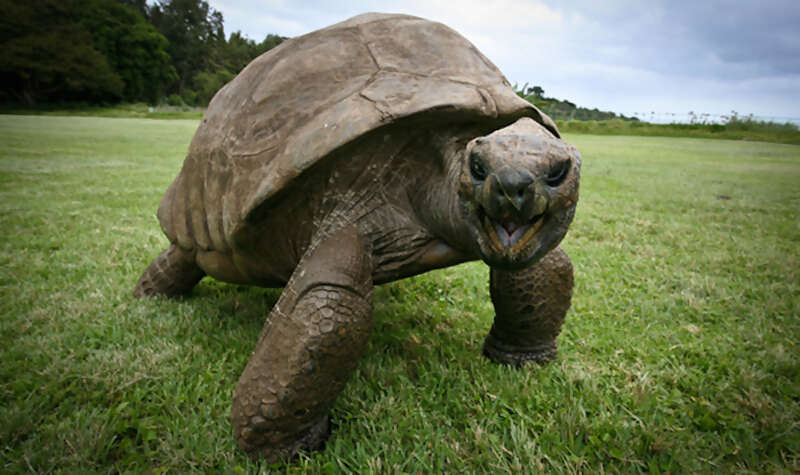
Jonathan in 2014
188-year-old turtle Jonathan will remind you that “everything will pass” amid coronavirus outbreak. This animal has lived through both the World Wars, the Russian Revolution, and changing of 39 U.S. presidents as well as seven British monarchs. It will also live through coronavirus, which is just the type of happy news we’re here for!
Born circa 1832 – five years prior to the coronation of Queen Victoria – Jonathan the tortoise turned 188 years old in 2020. That makes him the oldest-known land animal alive today. His estimated year of birth also predates the release of the Penny Black, the first postage stamp (1840), the building of the first skyscraper (1885) and the completion of the Eiffel Tower (1887) – the tallest iron structure. Other human milestones to have taken place in his long life include the first photograph of a person (1838), the first incandescent light bulb (1878) and the first powered flight (1903).
Now the oldest animal in the world – among terrestrial animals – Jonathan has outlived the oldest person ever by around 65 years. The greatest authenticated age for a human is a 'mere' 122 years 144 days, achieved by Jeanne Calment (1875–1997) from France.
Although originating from Seychelles in the Indian Ocean, Jonathan has resided on the remote island of St. Helena in the South Atlantic since 1882. St. Helena is perhaps best known for being the final resting place of Napoleon Bonaparte – who was exiled here after his defeat at the Battle of Waterloo in 1815. The banished emperor and Jonathan would never have met, though, as the former died more than six decades prior to the arrival of this record-breaking reptile.
When Jonathan was brought to St. Helena, he was already fully grown. Based on known data for this species, that would indicate he was about 50 years of age at the time (hence his estimated birth year of 1832, makes him the longest-lived animal on land). Jonathan was gifted to the then-governor of the Overseas British territory, William Grey-Wilson (in office 1890–97), and he has lived at the governor’s residence ever since.

Jonathan (left) with caretakers when he first arrived to St. Helena
Jonathan's home is the manicured lawns of 'Plantation', a Georgian mansion built by the East India Company in 1791–92. Today, he shares the grounds with three other giant tortoises: David, Emma and Fred.
For a long time, Jonathan was identified as an Aldabran tortoise from the Aldabra Atoll, which forms part of the Seychelles archipelago. However, a closer examination of his shell by the Seychelles Nature Trust (and several other zoological professionals) has raised the distinct possibility that he could be a much-rarer Seychelles giant tortoise. This particular species was once believed to be extinct, but there now may be around 80 globally, according to the IUCN’s Tortoise and Freshwater Turtle Specialist Group.
Considering his great age – he is already well beyond his kind’s 150-year average lifespan – Jonathan is in surprisingly good health. He hasn’t escaped completely unscathed, though. He is virtually blind due to cataracts and seems to have lost all sense of smell, but retains excellent hearing and a healthy appetite. He typically spends his days lounging in the sun, munching on grass and relaxing with his tortoise friends. It is a very calm life for someone of such status; he is so popular that his portrait is even on the back of the small island’s five pence coin.
Meet Galápagos tortoises on Special Travel International’s Galápagos & Peru tour (Feb 11–26, 2021).
On the Horizon for 2024-25
Travel the world with like-minded people, and discover how much shared enthusiasm increases your enjoyment of experiences tailored to your interests. All while you enjoy all the comfort and reassurance of traveling in a group. We believe in making extraordinary memories with friends, exceptional service and ethical business conducted with proven local partners.
Special Travel crafts unique tours for choirs, sport teams and many other special interest groups.
Contact Email
CLASSICAL MUSIC PLATFORM
Find out more about our artists and Classical Music partners
Click Here